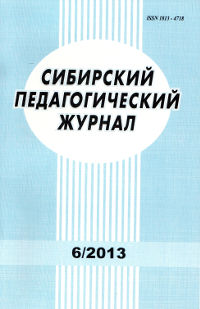Opportunities to Identify and Develop the Individual Abilities of Gifted Students in Modern Technological Education
1. Ignatieva, O. V., Lysenko, O. V., Chernikova, I. Yu., 2015. Tutor support as a factor of socialization of gifted children: monograph. Perm: Pushka Publishing House, 134 p. (In Russ.)
2. Stern, V., 1997. Mental giftedness: Psychological methods of testing mental giftedness in their application to school-age children. St. Petersburg: Soyuz Publ., 398 p. (In Russ.)
3. Bogoyavlenskaya, D. B., Brushlinsky, A. V., Kholodnaya, M. A., Shadrikov, V. D. [et al.], 2003. The working concept of giftedness, 2nd ed. Moscow: ICP Magister Publ., 90 p. (In Russ.)
4. Vygotsky, L. S., 1991. Imagination and creativity in childhood: a psychological essay: a book for teachers. 3rd edition. Moscow: Prosveshchenie Publ., 93 p. (In Russ.)
5. Davydov, V. V., 1996. Theory of developmental learning. Moscow: INTOR Publ., 544 p. (In Russ.)
6. Renzulli, J. S., 1986. The threering conception of giftedness: A developmental model for creative productivity. R. I. Sternberg, J. E. Davidson (eds.). Conceptions of giftedness. Cambridge: Cambr. Univ. Press, pp. 53–92. (In Eng.)
7. Torrence, E. P., 1980. Growing up creatively gifted: a 22-year longitudinal study. Creative child and adul quatery, no. 5, pp. 148–170. (In Eng.)
8. Galton, F., 1996. The inheritance of talent. Laws and consequences. Moscow: Mysl Publ., 272 p. (In Russ.)
9. Egorova, M. S., 2014. The study of development in the psychology of individual differences. Psychological research, vol. 7, no. 36, p. 12. (In Russ.)
10. Binet, A., Simon, T., 1923. Methods of measuring mental giftedness: A collection of articles / Translated by E. Elstein; Edited by S. L. Rubinstein. Kharkov: State Publishing House of Ukraine, 178 p. (In Russ.)
11. Eysenck, G., 2000. How to measure personality. Moscow: Kogito-Center Publ., 205 p. (In Russ.)
12. Wexler, D. D., 2000. Wexler’s test “Diagnostics of the structure of intelligence: adult option 2: methodological guide. St. Petersburg: IMATON Publ., 112 p. (In Russ.)
13. Druzhinin, V. N., Bogoyavlenskaya, D. B., Babaeva, Yu. D., 2017. Psychology of giftedness and creativity. Monograph. St. Petersburg: Nestor-Istoriya Publ., 288 p. (In Russ.)
14. Ilyin, E. P., 2009. Psychology of creativity, creativity, giftedness. St. Petersburg: Peter Publ., 448 p. (In Russ.)
15. Bogoyavlenskaya, D. B., Brushlinsky, A. V., Kholodnaya, M. A., Shadrikov, V. D. [et al.], 2003. The working concept of giftedness, 2nd ed. Moscow: ICP Magister Publ., 90 p. (In Russ.)
16. Komarov, R. V., 2017. Psychological 3D model of giftedness. Psychology of giftedness and creativity: monograph. St. Petersburg: LLC “Nestor-Istoriya” Publ., pp. 113–125. (In Russ.)
17. Gardner, G., 2007. Structure of the mind: theory of multiple intelligence: translated from English Moscow: LLC “I. D. Williams” Publ., 512 p. (In Russ.)




